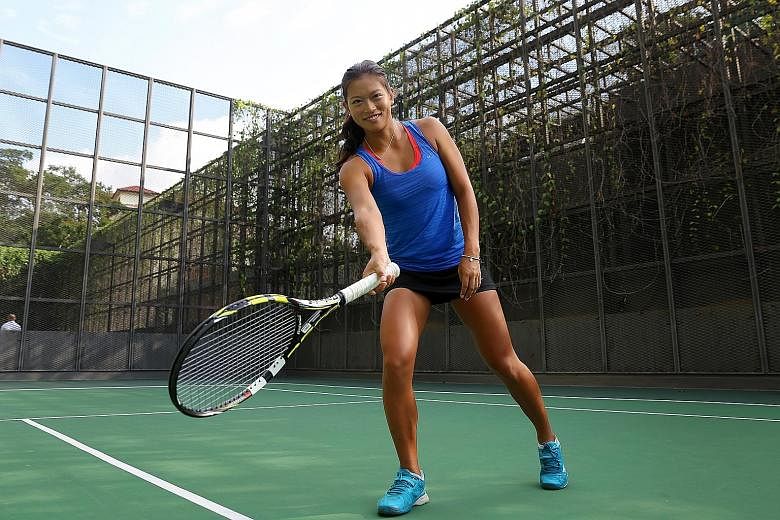Stefanie Tan has an MBA but these days, instead of going to work in a skirt and high heels at Raffles Place, her "office" is the tennis court and gym, where she pounds weights or balls for up to eight hours a day, six days a week.
After graduating from Texas Christian University (TCU) last year, Singapore's No. 1 tennis player returned home, sent out about 10 job applications and was offered a role in banking.
Tan, 23, said: "I thought I was going to come back to Singapore and be done with tennis. I think I felt society's pressure to work."
But at the turn of the year, she decided that she was not done with tennis yet and would give the professional circuit another shot.
"I felt like I haven't fulfilled my full potential in tennis yet. I know I can achieve more, but these four years I wasn't playing on the pro circuit," she said.
"If I don't do it now, I felt that I'd be letting myself down and it would never happen again.
"I'm kind of putting my future on hold. There's a lot of uncertainty in what I've chosen, in terms of getting a stable income, things you do when you plan for the future.
"But jobs will always be there in the end. I can do it after tennis."
Her parents, mechanical engineer Tan Hun Swee, 59, and civil engineer Annie, 57, supported their only daughter's decision.
Hun Swee said: "We were prepared to let her pursue the sport for a few years. Because once you take up a job, you cannot (it's hard to) go back to tennis full-time."
This is Tan's second foray into pro tennis. She had quit Raffles Institution as an 18-year-old in 2011 to train and compete full-time.
That decision paid off, as she was given a full athletic scholarship to study in the United States and play in Division One of the National Collegiate Athletic Association (NCAA) competition.
She said: "I think if I had stayed on in Singapore or in JC (junior college), I would not have been able to compete because of the heavy school workload.
"But over in the US, they place a lot of emphasis on sports."
As the main singles player for the TCU's Horned Frogs, she was playing week in, week out, even though she dropped out of the Women's Tennis Asssociation rankings.
She said: "I got an education there. I was playing a lot of matches there every single week."
Her Bulgarian coach, Boyan Hadjisotirov, 46, who has trained Tan since she was 14, noted: "During her junior days, the girls had different things on their mind, they were not so focused.
"But she's got a mature head now and she trains with a higher intensity. She's more determined and uncompromising in training. It's (feels like) about 40 deg C out in the sun and she trains four hours in the morning."
Now with her mind focused wholeheartedly on the sport, Tan has proved that she is a much improved player.
Her first professional singles title arrived last month at an International Tennis Federation US$10,000 (S$13,526) event, the lowest tier in the women's pro circuit, in Azerbaijan. That success was followed by a doubles title the next week.
She has cracked the top 1,000 for the first time and reached a career high of 856 (14 points) in singles and 892 in doubles.
But life in the lower ranks is a far cry from the top, where the likes of Serena Williams not only earn millions each year but also receive VIP treatment everywhere.
In Azerbaijan, with her tennis bag, Tan had to squeeze onto a public bus to get to the Baku Tennis Academy. The 10-minute bus ride cost less than 20 cents, and while a taxi ride would have cost about US$5 - not a particularly onerous amount to cough up - Tan has to watch every penny as her accounts are usually in the red.
For example, she spent $10,000 on four tournaments in Azerbaijan and South Korea, but earned just US$2,028 (S$2,743) in prize money.
She said: "I'm always in a big loss. It's unglamorous where I am. I'm cost-conscious and hunt for cheap tickets. There's nothing prestigious about that kind of lifestyle."
While Tan does not want to fix a ranking target, Hadjisotirov hopes she can crack the top 500 "at the minimum" by the end of this year. She plans to play 10 more tournaments this year, and 43 ranking points separate her from that mark.
By virtue of her ranking, she has qualified directly for the main draw for next week's US$10,000 ITF tournament in Hong Kong without having to play the qualifying rounds.
Tan, who is also pencilled in for a second event in Hong Kong the following week, hopes that her recent win will lead to further success.
She has drawn inspiration from many of her fellow 2010 Youth Olympic Games competitors, including current top-40 players Elina Svitolina and Monica Puig.
She said: "I feel like this is just the beginning. I'm a late bloomer. I want to give myself two years and then I'll re-evaluate."

